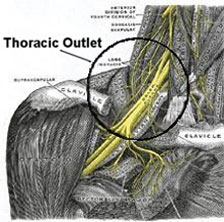|
Conditions & Treatments - Thoracic Outlet Syndrome (TOS) |
 Are you experiencing pain and/or tenderness in your neck, shoulder, arm and hand? Are you also experiencing numbness and tingling in these same regions as well? If this is your situation, then you may be experiencing a condition called thoracic outlet syndrome. This condition involves abnormal pressure to a nerve or blood vessel which can contribute to the above symptoms. Physical therapy is often utilized to help treat for thoracic outlet syndrome. |
|
What is Thoracic Outlet Syndrome?  The
region located in the upper chest and shoulder area between
the collarbone (clavicle) and first rib is called the
thoracic outlet. There are many nerves, blood vessels and
muscles which are located in this region. Thoracic outlet
syndrome (TOS) is often used to classify a set of disorders
which could affect the nerves that come from the neck and
passes into the arms (brachial plexus) and/or the blood
vessels which are located at the base of the neck and the
armpit (axilla). The causes of pressure on the
neuro-vascluar bundle of the upper extremity are many and
varied and can be difficult to explain in many cases (1).
(image from 20th U.S. edition of Gray's
Anatomy of the Human Body published in 1918) The
region located in the upper chest and shoulder area between
the collarbone (clavicle) and first rib is called the
thoracic outlet. There are many nerves, blood vessels and
muscles which are located in this region. Thoracic outlet
syndrome (TOS) is often used to classify a set of disorders
which could affect the nerves that come from the neck and
passes into the arms (brachial plexus) and/or the blood
vessels which are located at the base of the neck and the
armpit (axilla). The causes of pressure on the
neuro-vascluar bundle of the upper extremity are many and
varied and can be difficult to explain in many cases (1).
(image from 20th U.S. edition of Gray's
Anatomy of the Human Body published in 1918)
Thoracic outlet syndrome is usually the result of pressure on the nerves in 95% of the cases with the remaining percentage of cases affecting the artery or vein (2). Some of the causes of TOS can be attributed to: trauma ie. whiplash from a motor vehicle accident, repetitive activities ie. job duties (assembly line, typing), playing musical instruments, participation in sports, poor posture ie. forward head, forward shoulders, static posture, anatomical abnormalities ie. extra rib, abnormal positioning of scalenes muscles, pectoralis minor tightness, tight congenital fibromuscular band which connects the spine to the rib, or entrapment at the costoclavicular space (space between the first rib and collarbone) ie. back pack or purse over shoulder, carrying heavy objects. Symptoms can vary depending on which structures are being affected and compressed. Pressure on the nerves can result in: numbness and/or tingling at the palm, forearm, neck and shoulder; atrophy or wasting of the muscles of the hand; pain in the neck, shoulder, arm and hand; and cramps in the forearm. In contrast, pressure on the blood vessels can result in: sensation of heaviness in the arm and hand; swelling or edema in the arm or hand; easy fatigability of the arm and hand and a sensation of coolness in the arm and hand. A physical therapists can conduct an examination and utilize various clinical tests to determine if a patient has thoracic outlet syndrome. Additional medical tests such as: a X-ray, MRI, nerve conduction velocity test or ultrasound can be performed as well to rule out other possible causes for the symptoms |
Thoracic Outlet Syndrome Treatment Options for a P.T.
· Hot Packs/Ice Packs
· Postural Training/Functional Training
· ROM/Stretching (see videos 44, 45, 46, Z21, Z22)
· Strengthening (see video Z25, Z26)
· Massage/Soft Tissue Mobilization/Manual Therapy
· Joint Mobilization
· Ultrasound
| Comment - Message Board |
Last revised: June 6, 2008
by Chai Rasavong, MPT
References
1. Telford E, Mottershead S. Pressure at the Cervico-Brachio Junction - An
Operative and Anatomical Study. The Journal of Bone and Joint Surgery 1948;
30 B, No. 2:249-265.
2. Sanders, R.J., Haug, C.E. (1991). Thoracic Outlet Syndrome - A Common
Sequela of Neck Injuries. Philadelphia, PA: Lippincott.
|
|
|
|





